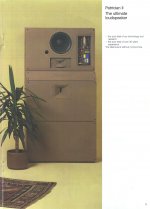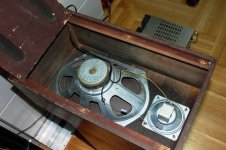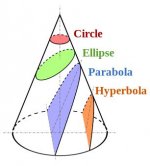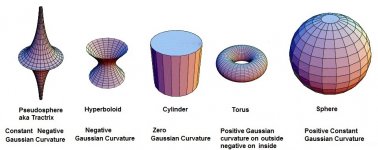Any examples of Australian speakers? They must be the biggest in the world?
Don't know of Australian speakers but I do know of an Australian guy who owns or owned a pair of Tannoy Westminsters alongside a pair of Electro Voice Patrician 2s.
(That is a 12" cone mid)
Attachments
and Toole explains why:
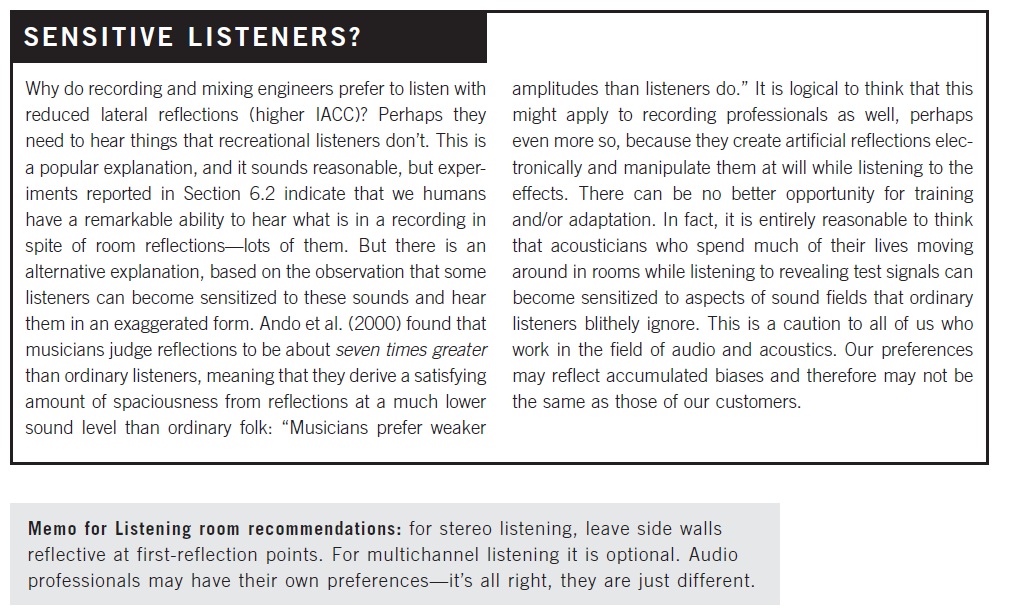
Beautiful post and probably very true. I've definitely noticed I could train myself to "hear" the room. Much harder to unlearn that though. I sometimes whished I didn't do that
However the very early reflections (within ~6 to 7 ms) can really affect imaging positions. Especially noticeable in a non symmetrical room setup.
It's much like a sauce that's poured over each recording. It doesn't have to be objectionable, but it was similar over a wide range of songs. In my own experiments, removing those reflections meant each recoding had more of it's own size and shape of the perceived image. That has become my preference. I can't blame anyone preferring something different though, as the removal of reflections had it's own downsides.
Last edited:
Toole and Olive ...are quite convinced that a constant (flat) DI with a subtle HF power response roll-off is necessary for the best possible reproduction.
They spent two lifetimes trying to show that subjective preference is statistically highest over the widest variety of playback environments if the speakers used in the recording chain and the playback speakers had this DI. It doesn't preclude other options or situations. It's more of a wise design target for commercial speakers and recording environments both, than a better design for specific situations.
Two additional ways to look at this:
As Dr Toole repeats often, the "circle of confusion" posits that the best replay environment mimics the intent of the recording environment, whatever that may be.
Or, looking at this another way, I never quite understood why Troels Gravesen almost always designed his speakers for reduced output the higher one went in frequency (on axis). Then I watched an interview with one of Kef design leads, and he clarified this resulted in higher preference in Europe due to the typically lower absorption in rooms. Flatter is arguably better for North America, but neither target is universally "better" or "worse"
I don't think the B&W 800 series with 12 and 15" woofers were constrained by size.
Interesting thing about B&W. The speakers that made their reputation were the "Matrix" series that got into Abbey Road, became Don Keele's reference, etc. These were designed by Lawrence Dickie, and basically followed the Toole/Olive criteria: flat and smooth FR on axis, smooth FR off axis.
The current B&W 800 series are designed totally differently. I haven't heard the latest line. They're so ungainly that I have no interest in listening. The previous generation at least looked more elegant.
If you want to see what the designer who put B&W on the map is doing now, here's a glimpse:
Vivid Audio Giya G3 loudspeaker Measurements | Stereophile.com
I've definitely noticed I could train myself to "hear" the room. Much harder to unlearn that though. I sometimes whished I didn't do that.
Yes, one of the reasons I've not gone out of my way to pick up on various imperfections. Once you can do it I imagine it is very hard to turn off!!
On the Australian speakers... Duntech would be an example of shallow, they use first order (I believe acoustic) crossovers. Duntech Audio
Krix is another Australian manufacturer though I don't know what sort of crossovers they use Floorstanding | Krix
Tony.
Interesting thing about B&W. The speakers that made their reputation were the "Matrix" series that got into Abbey Road...
Always bear in mind that B&W got into Abbey Road because of sponsoring, not because they were any better than the Quested systems they used before.
The Abbey Road engineer I spoke to claims the contrary ie the B&W/Classé combination that replaced active Quested systems in some rooms are clearly inferior. In other rooms they still use Quested but B&Ws are moved in for any official photos.
People who have been to Abbey Road recently say that the place is cluttered up with top-of-the-range B&Ws, they are everywhere: Shoved into corners, filling up broom cupboards and a few are actually connected and working!
They spent two lifetimes trying to show that subjective preference is statistically highest over the widest variety of playback environments if the speakers used in the recording chain and the playback speakers had this DI. It doesn't preclude other options or situations.
...
he clarified this resulted in higher preference in Europe due to the typically lower absorption in rooms. Flatter is arguably better for North America, but neither target is universally "better" or "worse"
I don't suppose that the results of anyone's research would preclude there being other solutions. However, it seems wise to me that in the absence of any solid evidence of alternative solutions that one would go with what we have.
I don't know how much others roll off their high end, but I have also found this to be preferred even here in NA. Maybe they do this more than I do, I don't know. I find that as the DI becomes flatter at the high end, the sound seems brighter, requiring more falloff for a natural sound. To me this represents the natural condition of sound in nature where higher frequencies get rolled off with propagation from air absorption. When we playback in a small space there isn't enough "space" to yield this natural roll-off so we add it in ourselves.
Great thread, boys and girls! All we know about our Universe (and our hypothetical Creator) really is that it is an EXTREMELY interesting place. If there is a Creator, he is certainly brighter than us little arboreal (tree-dwelling) creatures! 
My own view, is that our Universe is designed to please living creatures at any level. Whether you are a Hebrew shepherd looking at the seemingly constant stars at night in ancient days, or a Hebrew scientist considering the seemingly invariable laws of physics in the less sane C20. The Universe seems to have no plot holes. It's a masterpiece.
FWIW, we have far more acoustic senses than just our ears. We have the hairs on the back of our necks (and cheeks if we guys didn't shave) which can pick up frequencies up to about 40kHz. We are always aware of height and nearby precipices and caves from some gut vibration feeling in our stomachs that makes us nervous of falling to our deaths (around 5Hz I think).
So on a dark night when our monkey eyes don't help much, we are not only aware of what is around us which might be a predator, we are aware of a cliff we might fall off, or a rock wall we might bump into. You follow?
In fact, the strength of arboreal (tree-dwelling) creatures like us, who will only fall to the ground once, because that would be terminal, is a tremendous spatial awareness. 3 dimensional.
At a mathematical level, not only does the geometry of the device matter, it also matters what the space is that it is embedded in. This is Bernhard Riemann stuff. Which means the speaker geometry matters, and also the room.
My own view, is that our Universe is designed to please living creatures at any level. Whether you are a Hebrew shepherd looking at the seemingly constant stars at night in ancient days, or a Hebrew scientist considering the seemingly invariable laws of physics in the less sane C20. The Universe seems to have no plot holes. It's a masterpiece.
FWIW, we have far more acoustic senses than just our ears. We have the hairs on the back of our necks (and cheeks if we guys didn't shave) which can pick up frequencies up to about 40kHz. We are always aware of height and nearby precipices and caves from some gut vibration feeling in our stomachs that makes us nervous of falling to our deaths (around 5Hz I think).
So on a dark night when our monkey eyes don't help much, we are not only aware of what is around us which might be a predator, we are aware of a cliff we might fall off, or a rock wall we might bump into. You follow?
In fact, the strength of arboreal (tree-dwelling) creatures like us, who will only fall to the ground once, because that would be terminal, is a tremendous spatial awareness. 3 dimensional.
At a mathematical level, not only does the geometry of the device matter, it also matters what the space is that it is embedded in. This is Bernhard Riemann stuff. Which means the speaker geometry matters, and also the room.
Attachments
Just leaving these here:As someone who has been in this hobby for 50 years now, and stopped to get an electrical engineering degree somewhere along the way, I am greatly amused by some of the arguments on these boards and those who believe that engineering is actually ruled by inviolable concepts and theories. The absolute best definition of engineering I have ever come across is “the art of figuring out which parameters can be safely ignored.”On another thread someone wrote something to the effect that those who crossed over at or above 3 KHz ignoring the directivity index were fools who had no idea what they were doing.
That comment made me draw up a short list of fools who did not know what they were doing and whose speakers must have had terrible midrange.
These people were either fools or they figured out that gains could be made in other areas by compromising some directivity. They succeeded in creating great products becausethey figured out what and how much could be safely ignored.
- The entire BBC team who thought 8” drivers could be crossed over at 3 KHz in their monitors.
- Spendor, from the original BC1 (8”) to the current D7 (7”) crossing at 3 KHz
- Harbeth who still think you can cross 8” woofers at 3 KHz.
- Bowers and Wilkins who still think you can cross 6” drivers at 4 KHz in their flagship 800 series.
- Aerial Acoustics who take an SB 5” Papyrus mid to 3KHz in their 7T
- Sony with their SS-AR1 who think that they can take a Scan 15M Revelator from 400 to 4 KHz
- The biggest fool had to be Peter Walker of Quad who thought you could take a wide flat panel to 7 KHz before crossing to a narrow strip
Lighten up guys. None of us have absolute answers.
I apologize to any other fools I neglected to mention.
Argument from authority - Wikipedia
Argumentum ad populum - Wikipedia
*silently tiptoes away*
Just leaving these here:
Argument from authority - Wikipedia
Argumentum ad populum - Wikipedia
*silently tiptoes away*
"silently tiptoeing back in"
Showing examples where the authoritative rule with appeal to two authorities posted before was successfully ignored, is not an appeal to authority since none of them have actually expressed their method as "the way". Your logic therefore escapes me.
"tiptoeing back out"
IMO, guys, there are two sorts of people in the World. Those who will die young and those who will die old. AFAIK, the best personal strategy is to die old. Because you have much more fun that way. 
I never used to understand why people lived fat and stupid lives, full of denial, living on Coca Cola and Crisps and getting overweight and unhealthy. The facts of our Universe are that you are either Quick or you are Dead. This is why, you might not fancy the occasional encounter with a Shark whilst swimming. But if you are Quick, you punch it on the nose, leave it stunned and clear off as fast as you can. Evolution, in a word. The alternative is Dead.
My advice to you is to try to pick out the stuff that matters. And ignore the stuff that doesn't matter.
There's an old Jewish Proverb that says that 90% of everything is dreck. Which in Yiddish means rubbish.
Anybody with any smarts who hangs round the forums knows this to be true.
Multiway is actually fascinating nonsense. Multiway is actually WRONG. But it is discovering why multiway is wrong that gives you insight.
If I really wanted a musical illusion, I would listen to the best headphones in the World:
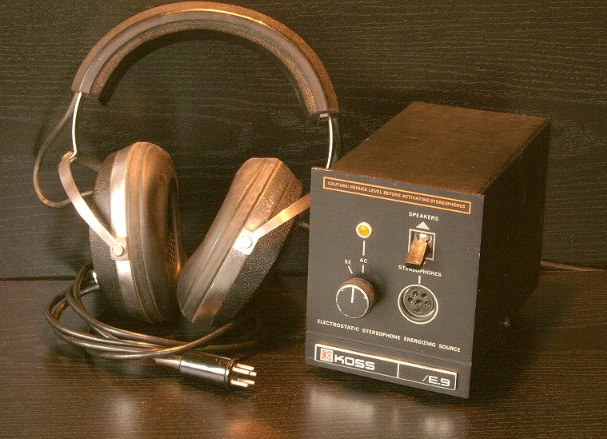
But that is lonely and solitary stuff. I want to share Music with Everybody.
Here's something that is not perfect, but a lot to like:

We just do our best.
I never used to understand why people lived fat and stupid lives, full of denial, living on Coca Cola and Crisps and getting overweight and unhealthy. The facts of our Universe are that you are either Quick or you are Dead. This is why, you might not fancy the occasional encounter with a Shark whilst swimming. But if you are Quick, you punch it on the nose, leave it stunned and clear off as fast as you can. Evolution, in a word. The alternative is Dead.
My advice to you is to try to pick out the stuff that matters. And ignore the stuff that doesn't matter.
There's an old Jewish Proverb that says that 90% of everything is dreck. Which in Yiddish means rubbish.
Anybody with any smarts who hangs round the forums knows this to be true.
Multiway is actually fascinating nonsense. Multiway is actually WRONG. But it is discovering why multiway is wrong that gives you insight.
If I really wanted a musical illusion, I would listen to the best headphones in the World:
But that is lonely and solitary stuff. I want to share Music with Everybody.
Here's something that is not perfect, but a lot to like:
We just do our best.
I don't suppose that the results of anyone's research would preclude there being other solutions. However, it seems wise to me that in the absence of any solid evidence of alternative solutions that one would go with what we have.
I don't know how much others roll off their high end, but I have also found this to be preferred even here in NA. Maybe they do this more than I do, I don't know. I find that as the DI becomes flatter at the high end, the sound seems brighter, requiring more falloff for a natural sound. To me this represents the natural condition of sound in nature where higher frequencies get rolled off with propagation from air absorption. When we playback in a small space there isn't enough "space" to yield this natural roll-off so we add it in ourselves.
Designing speakers for myself and my own rooms, I find the Toole/Olive method certainly gives best room to room sound, but optimal sound in any room calls for specific on axis and off axis tradeoffs. I've spent years "voicing" 6 to 10 crossovers itterations each for different speakers for different rooms in my home.
I find many flat speakers too hard to handle. Our DIY get together showcase popular kit builds designed flat on paper and most of those are glaring. Even a bit of excess 6 to 8 khz is too hard to handle. IME rolling the top end is a safe choice but lower fidelity to "carefully flat". Regarding air absorption, I think we're back to the 'circle of confusion" The recording side should take care of that.
I get to attend 10 to 20 live classical/chamber concerts a year, and it sounds like maybe you like the balcony. I'm more of a row J to M listener.
iter, from latin, means way, path.crossovers itterations each for different speakers ...
Ittero is when you look yellowish, and means that you have too much bilirubina in your blood
I get to attend 10 to 20 live classical/chamber concerts a year, and it sounds like maybe you like the balcony. I'm more of a row J to M listener.
There is a story I once read where a particular audio journalist could never understand why the speakers of one of our famed New England companies sounded the way they did. One day one of the founders offered him some concert tickets from his season package that he would not be able to use. He said after the concert from not exactly the best seats in the house, he finally understood the particular sound.
iz whatchew meen when nut spelt checquingiter, from latin, means way, path.
Ittero is when you look yellowish, and means that you have too much bilirubina in your blood
Makes perfect sense. I tried balcony at NAC for a twist and the excess bass was punishing; floor seats are subject to "floor bounce" and I think the conductor balances for the floor seatingThere is a story I once read where a particular audio journalist could never understand why the speakers of one of our famed New England companies sounded the way they did. One day one of the founders offered him some concert tickets from his season package that he would not be able to use. He said after the concert from not exactly the best seats in the house, he finally understood the particular sound.
This has been a very interesting discussion.
One question for you, dr. Geddes. I've always read your work with great interest. Following up on this comment:
What I've been wondering, is why you've never made an attempt to explore omnidirectional speakers in earnest? If you can't beat the room, why not work with it, and make the reflections as similar as possible to the first wave arrival? My experience so far is that the speakers I've liked the most are polar opposites (pun intended) when it comes to directivity: I like very much highly directional speakers, whether cardioids or big horns, and I also like very much speakers with very wide directivity, as long as it's even with frequency. What I don't like so much are the ones in the middle.
So there doesn't seem to me to be any a priori reasons to exclude omnidirectional speakers from the possibilites to explore, especially for a creative person like you. The problem with most actually existing "omnis" though is that they are not truly omnidirectional, and this may give them a somewhat smeared presentation, as reflections from some directions become much more dominant than reflections from other directions. So I would love to see more smart engineering minded guys try to come up with something better! (I know that you're out of the speaker maker game now, but hypothetically)
One question for you, dr. Geddes. I've always read your work with great interest. Following up on this comment:
A low DI could not achieve "still avoiding the early reflections" SInce it send sound in many more directions there is inherently more early reflections. And since the reverberant field is an integration of the sound from all directions, i.e. the power response, the DI is not a factor. So I would have to say "no" a low DI will not achieve what you suggest.
Critical to listening in a small room is the amount of time between the first arrival and the onset of reflections and reverberation. In an auditorium this time lag is very long and in a small room it is very short, except that in a small room it is highly dependent on the DI. The higher the DI the greater this time lag will be.
What I've been wondering, is why you've never made an attempt to explore omnidirectional speakers in earnest? If you can't beat the room, why not work with it, and make the reflections as similar as possible to the first wave arrival? My experience so far is that the speakers I've liked the most are polar opposites (pun intended) when it comes to directivity: I like very much highly directional speakers, whether cardioids or big horns, and I also like very much speakers with very wide directivity, as long as it's even with frequency. What I don't like so much are the ones in the middle.
So there doesn't seem to me to be any a priori reasons to exclude omnidirectional speakers from the possibilites to explore, especially for a creative person like you. The problem with most actually existing "omnis" though is that they are not truly omnidirectional, and this may give them a somewhat smeared presentation, as reflections from some directions become much more dominant than reflections from other directions. So I would love to see more smart engineering minded guys try to come up with something better! (I know that you're out of the speaker maker game now, but hypothetically)
oivavoi
This is an interesting point and goes directly to a rather lengthy discussion that we had on our local audio clubs forum.
But first let me say that designing a speaker with a DI=0 dB across its bandwidth would be extremely difficult, certainly impractical. I have heard, many times, what are considered "omni" loudspeakers and what I most disliked was their complete lack of any imaging quality.
Which brings me to the other discussion. At its root is ones personal listening taste. We settled on two camps; studio work and field recordings. In studio work there is usually a very solid concrete image created in the studio with no acoustical reference at all. It is created in the studio as a work on the canvas of the loudspeakers and as such it is theoretically possible to have a perfect reproduction of this work. Field recordings, on the other hand, can never perfectly recreate the sound field they record and the best that they can do is to create in the listening space an "illusion" of what the original sounded like. This is sometimes refereed to as the "they are here" versus "you are there" effect.
For studio work playback one wants to recreate the original image and this requires a suppression of the very early reflections and diffraction that mess up this image. The loudspeaker tone should closely match those of the studio speakers and this leads to the "circle-of-confusion" that Toole talks about, but that's another discussion. Certainly no studios use omnis for their mastering.
For field work we know that more room reflections yield a more spacious sound thus helping to create the illusion of being in the large recording space.
These two requirements are diametrically opposed and no loudspeaker design can ideally meet both. For studio work a High DI is desired and the playback room size is not a huge issue. For field work a lower DI (but still smooth and constant) is desirable and the larger the room the better the illusion.
I am a big fan of studio work and hardly ever attend live concerts of acoustic instruments, although I have attend probably 50+ in my lifetime. I find recording playback of field work of the larger venues to be disappointing when compared to the real event. So I can like a live orchestra and not like its recording.
My playback system is ideally targeted at recreating the studio image and so are my designs.
Mono-poles may work very well for orchestral work in a large room, but I neither have a large room nor care to recreate orchestral work.
You need to know where you tastes lie as this is critical to the design of the system that you should choose.
This is an interesting point and goes directly to a rather lengthy discussion that we had on our local audio clubs forum.
But first let me say that designing a speaker with a DI=0 dB across its bandwidth would be extremely difficult, certainly impractical. I have heard, many times, what are considered "omni" loudspeakers and what I most disliked was their complete lack of any imaging quality.
Which brings me to the other discussion. At its root is ones personal listening taste. We settled on two camps; studio work and field recordings. In studio work there is usually a very solid concrete image created in the studio with no acoustical reference at all. It is created in the studio as a work on the canvas of the loudspeakers and as such it is theoretically possible to have a perfect reproduction of this work. Field recordings, on the other hand, can never perfectly recreate the sound field they record and the best that they can do is to create in the listening space an "illusion" of what the original sounded like. This is sometimes refereed to as the "they are here" versus "you are there" effect.
For studio work playback one wants to recreate the original image and this requires a suppression of the very early reflections and diffraction that mess up this image. The loudspeaker tone should closely match those of the studio speakers and this leads to the "circle-of-confusion" that Toole talks about, but that's another discussion. Certainly no studios use omnis for their mastering.
For field work we know that more room reflections yield a more spacious sound thus helping to create the illusion of being in the large recording space.
These two requirements are diametrically opposed and no loudspeaker design can ideally meet both. For studio work a High DI is desired and the playback room size is not a huge issue. For field work a lower DI (but still smooth and constant) is desirable and the larger the room the better the illusion.
I am a big fan of studio work and hardly ever attend live concerts of acoustic instruments, although I have attend probably 50+ in my lifetime. I find recording playback of field work of the larger venues to be disappointing when compared to the real event. So I can like a live orchestra and not like its recording.
My playback system is ideally targeted at recreating the studio image and so are my designs.
Mono-poles may work very well for orchestral work in a large room, but I neither have a large room nor care to recreate orchestral work.
You need to know where you tastes lie as this is critical to the design of the system that you should choose.
- Status
- This old topic is closed. If you want to reopen this topic, contact a moderator using the "Report Post" button.
- Home
- Loudspeakers
- Multi-Way
- Well I suppose the shallow vs. steep argument will just go on and on
